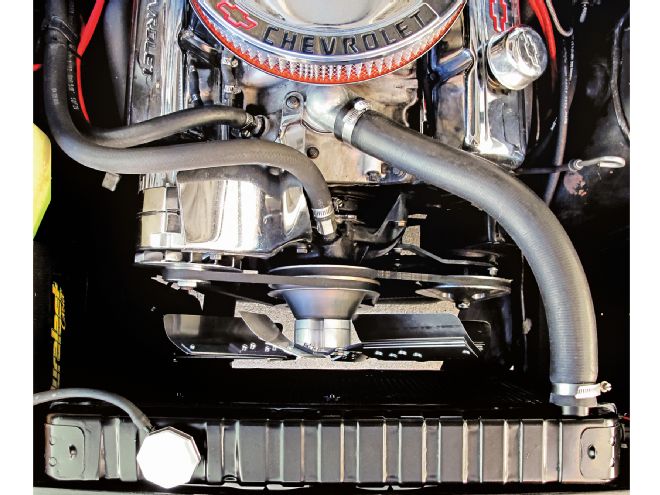
It's amazing how many homebuilt cars—as well as a few professionally built ones—suffer from cooling issues, whether it be full-blown overheating or simply running too hot. There can be any number of reasons for this, though more often than not it's caused by the radiator simply not being up to the task at hand, closely followed by the fan, or fans, not moving enough air through the radiator core.
We had a couple of cars with different problems, our '46 Ford roadster pickup, and a friend's '63 Chevy Nova wagon. The latter had received a GMPP crate 350 in place of the stock six a couple years ago, with a new water pump and radiator to match. However, in the heat of the summer it was noticed that the wagon had started to run a little warmer than what had been a 195-degree norm, especially in rush-hour traffic, more than once requiring exiting the freeway to cool down. With all-new parts used during the conversion, the cause was a mystery. Rather than take a shot in the dark by replacing parts one by one (though admittedly this would have answered the question of why the wagon was overheating), our buddy sought the advice of an expert, namely Don Armstrong , owner of U.S. Radiator.
After checking out the wagon, Armstrong suggested the following: remove the plastic low-flow flex fan and replace it with a high flow and more efficient 17-inch, seven-blade fan, switch the 180-degree thermostat for a 160-degree version, replace the radiator with a copper/brass version with a high-efficiency four-row core, and fabricate blanking plates to prevent hot engine compartment air from re-circulating over the core support and passing through the radiator, a problem which can happen at idle or low highway speed. We could have gone further and added a fan shroud to the Nova, but found it unnecessary. With these mods done, the wagon once again was running at 170 degrees, whatever the traffic, proving a little solid information can go a long way.
While Armstrong was at our Tech Center inspecting the wagon, we took the opportunity to have him give our pickup the once-over. While it's never let us down (OK, it's overheated a couple of times traversing the infamous "Grapevine" over the mountains north of Los Angeles), and has traveled through many states, its constant hot-running has always been cause for concern, especially on long mountain grades. We knew the radiator was a weakling two-row core, but had persisted with it mainly because it was such a bear to remove and replace! Stupid we know, but with a crossflow radiator mounted so each end tank is under the fenders, the only way to get it out was from underneath, and we'd welded in the crossmember that supported it, in a typical last-minute rush to get the truck running years ago!
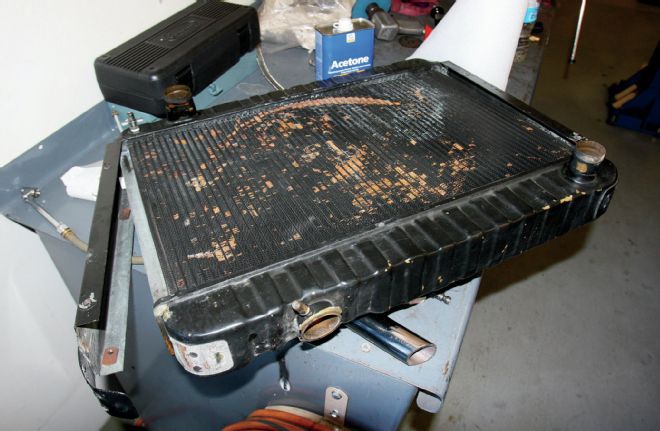
1. The radiator removed from the Nova was not only inadequate for the job, but the side plate had come away from the top tank too. This radiator, installed when the V-8 replaced the straight-six, would be replaced by a high-efficiency version from U.S. Radiator.
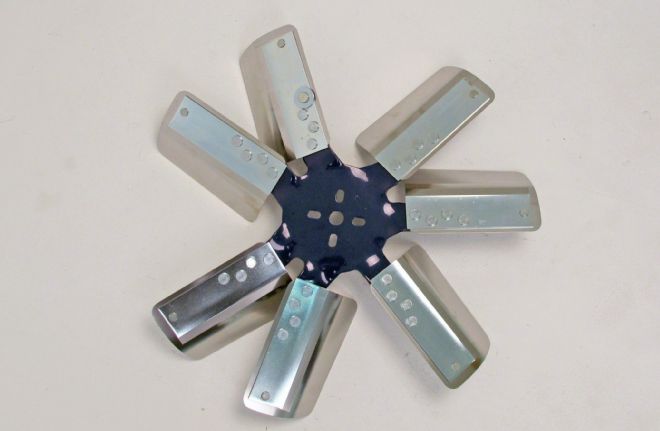
2. Flex-a-lite's 17-inch seven-blade flex fan is designed to pull air through a three- or four-row radiator, and is quieter in operation than most flex fans, too.
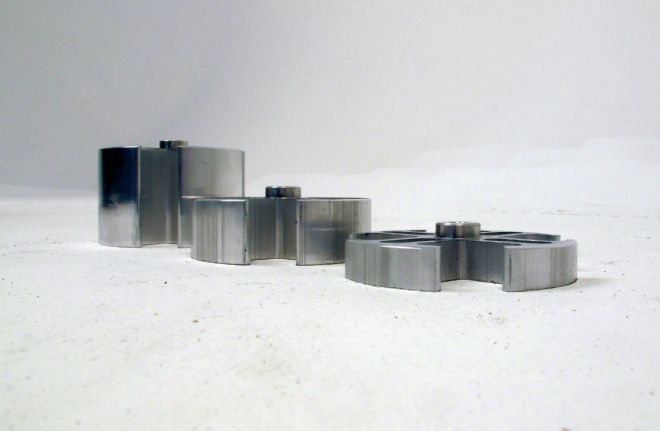
3. Flex-a-lite also supplied a selection of fan spacers to fine-tune the gap between the new flex fan and the radiator core.
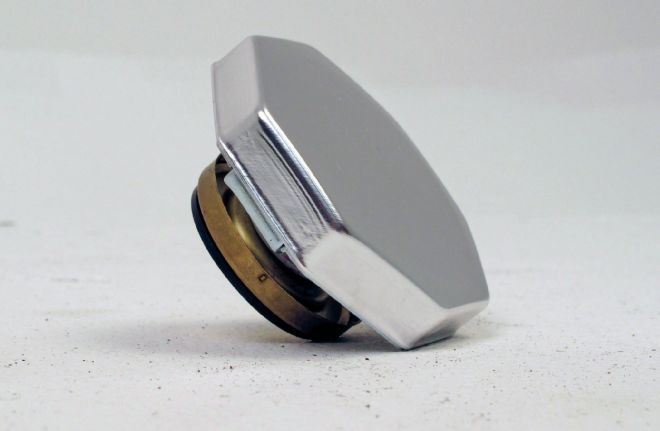
4. We added a 16-psi–rated cap to the new radiator.
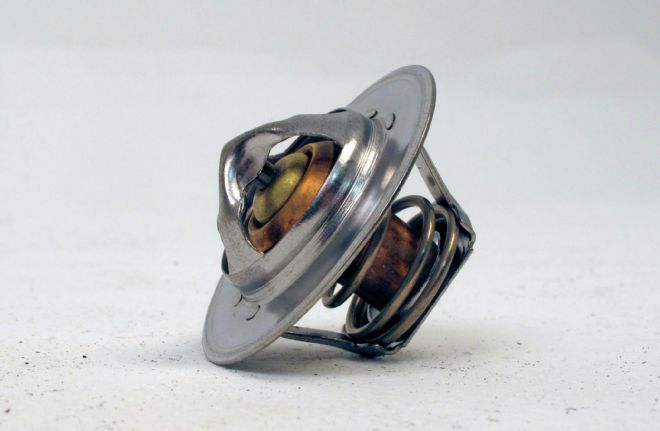
5. This 160-degree thermostat also came from Flex-a-lite, and replaced the existing 180-degree unit in the Nova.
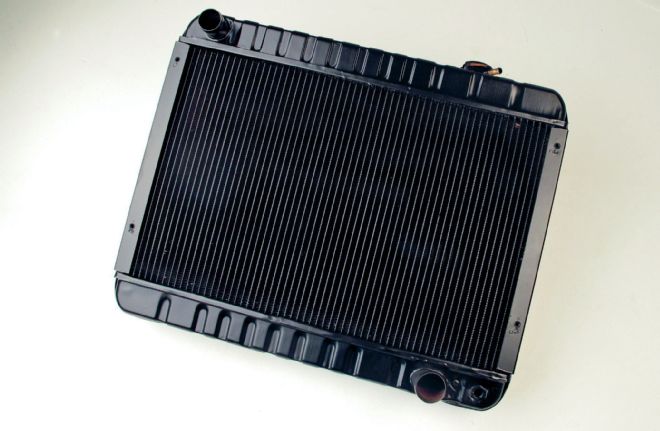
6. The new copper/brass radiator is similar to what GM used to cool 350hp 327 engines, but with a higher efficiency four-row core. U.S. Radiator can fabricate aluminum or copper/brass versions, but rate the latter for their higher efficiency when comparing like for like.
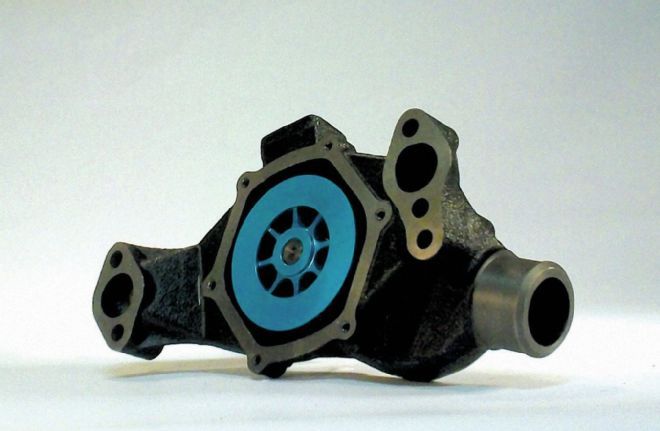
7. Though we didn't use it on the Nova, high-flow water pumps can sometimes be a help when troubleshooting overheating issues. FlowKooler high-flow water pumps resolve low-speed heating problems by doubling flow rates at low rpm and idle. They can also delay the onset of cavitation at higher rpm.
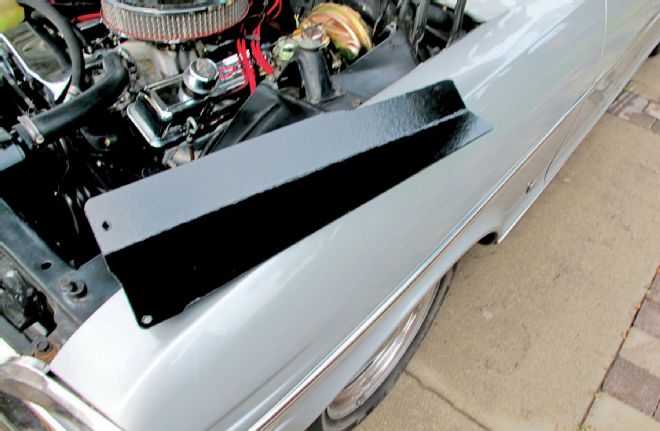
8. The Nova has an open space between the top of the grille and the core support, which allows hot air from the engine bay to flow up and over the support and into the radiator core at low speeds or when stationary. These blanking plates were made from heavy-duty construction board, having the extra benefit of forcing cool air through the radiator rather than over it at speed.
Armstrong lent us his airflow meter to see just how poorly the single electric fan was pulling air through the grille and radiator core. To be fair, this fan didn't cover enough of the core, and despite its best attempts, was working with a radiator far too small. It was time to retire it! With a new three-row core and triple-flow design from U.S. Radiator, we cut out the old crossmember and fabricated a new removable one. The thicker core meant we had to kick the bottom of the radiator out toward the front of the car and subsequently modify our blanking panels to suit. We also had to mount a transmission cooler behind the grille, as previously this had been handled by the cooler in the old radiator. The triple-flow design of the new one meant this wasn't an option, so an aftermarket one was bought and installed. The few hours of work involved for all this should really have been tackled years ago, as the truck now runs below 190 degrees, in turn keeping the driver from overheating too! Roll on summer and a trip over the Grapevine...
HOT TIPS
1. There are generally three types of overheating scenarios that will lead us in the most direct path to identifying the problem and parts necessary to fix.
A) Overheating that occurs after the thermostat opens and continues to climb until the engine is shut down. This is the least common and generally requires a complete system review and upgrade. Start with the least expensive parts and hope that you've solved the problem before you get to the radiator, but don't rule it out.
B) Overheating that occurs at low speed or at idle but goes away once the vehicle is moving into constant highway speed. This is the most common and usually indicates coolant or airflow issues. The good news is you can usually rule out radiator issues and focus on water pump, fan blade, fan clutch, and shroud or air dam components.
C) Overheating that occurs at high speed but goes away at idle or low speed. This form of overheating usually involves an inadequate-sized radiator or partially blocked radiator that cools fine when there's little horsepower being produced but can't keep up with high-horsepower heat generated at speed. It can occasionally involve a water pump, so start there and move on to the radiator.
2. One of the most common misconceptions about cooling is that an aluminum radiator cools better than copper/brass. This only holds true when comparing a 3⁄8-inch high-efficiency aluminum fin core to a '60s-style standard automotive ½-inch fin copper/brass core. When both radiators are compared using the 3⁄8-inch high-efficiency fin height the additional tubes in the copper/brass radiator makes it far more efficient than its aluminum counterpart.
A) Another popular misconception is a three-row aluminum core cools better than a two-row aluminum core. Heat transfer can only happen where the fin touches the tube or water passage and it's referred to as fin bond area. Two rows of 1-inch tubes indicates 2 linear inches of fin bond where a three-row aluminum core using a 5⁄8-inch tube only has 17⁄8 inches of fin bond and actually produces less heat transfer.
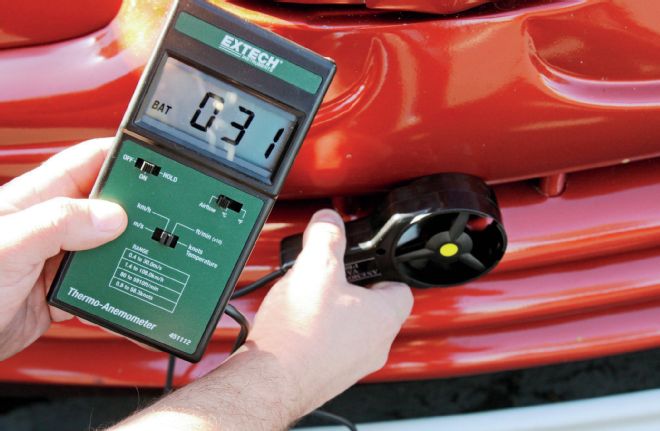
9. We got slightly more scientific when it came to our 1946 Ford, as we knew the water pump was new last year and it already has a 160-degree thermostat. More to the point, we knew the radiator was a puny two-core item, likely from a six-cylinder car. We used an airflow meter to determine the air velocity through the radiator with the electric fan on.
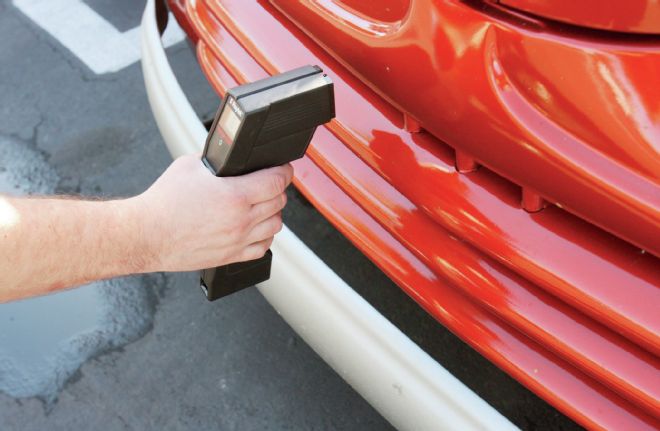
10. We also measured the temperature of the radiator core with the engine at operating temperature, rather than rely on the gauge, which was always at or above 210 degrees, regardless of traffic speed. The only time the engine ever stayed below 210 was on cool rainy days, not exactly common in Southern California!
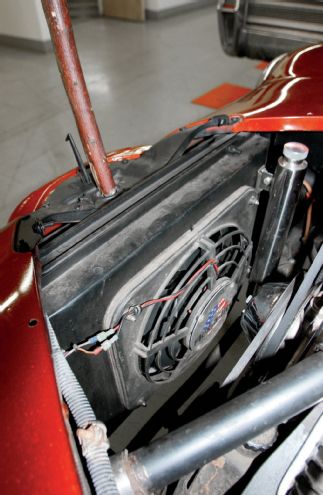
11. Here's the old radiator, with my homemade shroud and single electric fan, which, though it had done sterling duty, didn't cover enough of the core and was no match for the too-small radiator core.
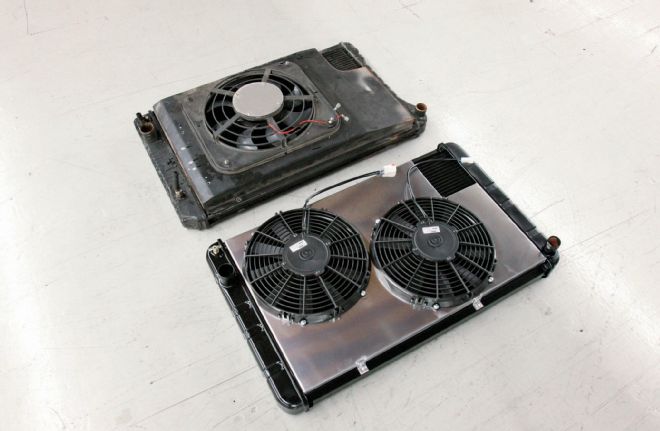
12. Compared side by side, its obvious how much more cooling capability the new twin SPAL fans will offer. That cutout in both shrouds is to clear the steering box on the Caprice front clip.
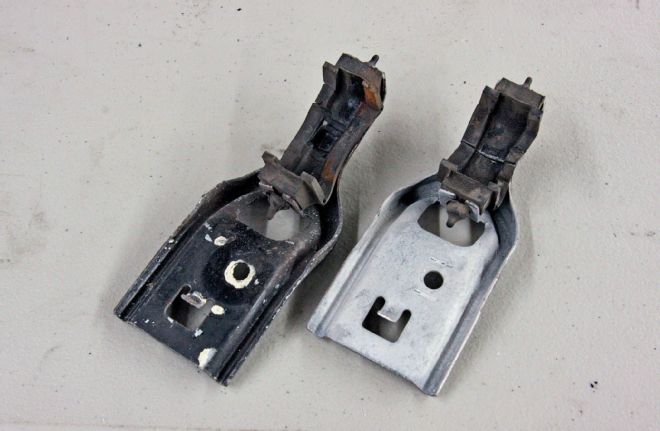
13. Sometimes the junkyard can be your friend. We bought four radiator upper supports from a couple of late-model Fords for the grand sum of $8, media blasted them, then cut them down on the bandsaw to suit the thickness of our radiator, cutting the rubber inserts by the same amount (seen on right).
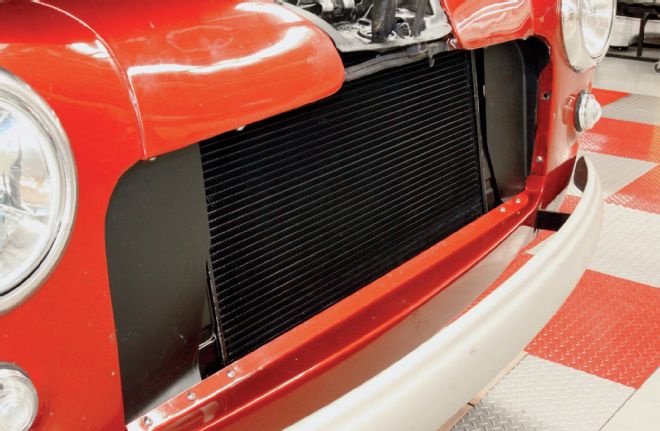
14. The new radiator mounted in place. Owing to its increased thickness, we had to kick the bottom out toward the front of the car, necessitating slight modifications to the lower inner corners of the blanking panels that direct all airflow through the radiator.
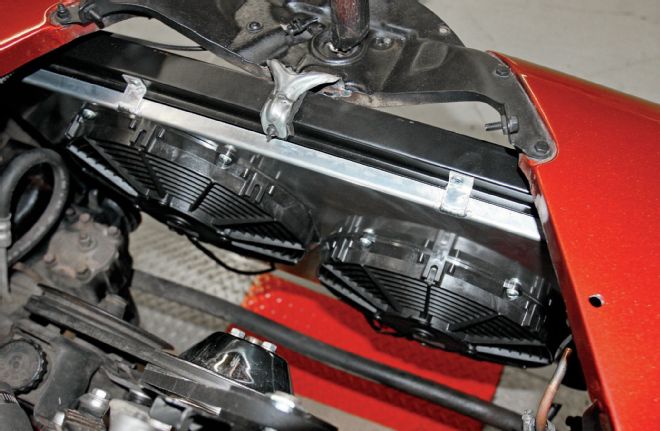
15. We used one of the junkyard-sourced radiator supports to hold the top of the radiator, welding it to the slam panel, which will be repainted. All that remains now is to install a new transmission fluid cooler, as this was previously located in the radiator end tank, but the triple-flow design of the new radiator precludes this.
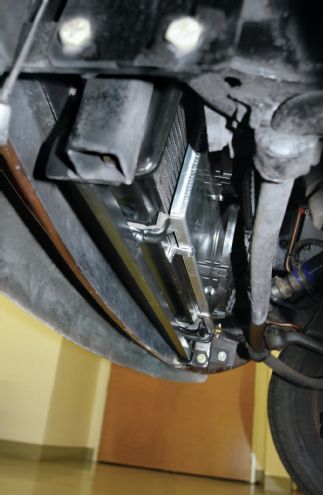
16. We fabricated a simple crossmember with two of the "reconditioned" support brackets trimmed and welded to it to locate the new radiator. As with the unit it replaced, the radiator is removed from the bottom, as it sits under the front fenders.